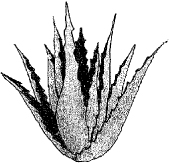
Aloe vera
OTHER USEFUL PLANT GROUPS |
8 |
WHILE A FEW INDIVIDUAL PLANT SPECIES are listed here, sometimes plant groups (genus or family) are discussed, primarily because several species in that group are very useful plants. While the neem tree and drumstick tree are specific species, the genus Yucca and the tribe Bambuseae (bamboo), for example, are discussed.
» DID YOU KNOW?
When organisms are classified they are placed in a taxonomic rank. When I was younger I learned that Kings Play Chess On Flat Glass Sheets (kingdom, phylum, class, order, family, genus, species), but as more research has been undertaken on organisms and their relationships, other categories of groups have been created. As an example, starting with family, we now include tribe, genus, section, series, species, variety, form (and even subfamily, subtribe, subgenus, subseries and subspecies and so on).
Aloes are succulents and store water in their fleshy leaves. Most have reduced stems, with a rosette (circular ring) of leaves emerging from the ground.
The gel from the leaf of the most well-known aloe, aloe vera, is used to soothe insect bites, burns and cuts, and ongoing research is investigating the validity of these traditional medical uses.

Aloe vera
Cacti include a wide range of species that are found in deserts throughout the world. These succulents are a source of water, food, medicine and useful tools (such as spines for fish hooks, needles).
Cacti have spines (modified leaves), which protect them from grazing animals. The stems contain chlorophyll for photosynthesis and they are water storage organs.
A truly multifunctional tree of the desert. Besides the well-known edible fruits of the date palm (which are also used in the production of syrup, breads and cakes), the leaves of the tree can be used to make furniture, thatching for houses and baskets, and the sweet sap of the tree can be tapped to make palm sugar, molasses and wine.
Date palm seeds can be ground into flour, the leaf sheaths can be made into rope and even the flowers are edible.

Date palm
A number of species of tough grasses that cover about one-quarter of Australia, spinifex thrive in the poorest of soils and the driest of conditions. They can be found in deserts (Triodia) and sand dunes (Spinifex). Their extensive roots hold soil, their seeds are food for many birds and animals, and their spiky nature provides habitat for lizards, birds and small mammals.
Aborigines extracted resin from the base of Triodia stems and melted it to make an adhesive (gluing stone chips onto wooden spears) and they ground the seeds into flour.
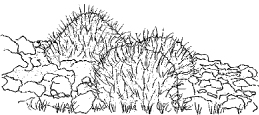
Triodia spinifex in central Australia
Yuccas are from the Americas, and different species exist in a wide range of climates and soils.
While these plants are mostly grown today as ornamentals, Native Americans made soap using the detergent-like compound from the sap of the yucca roots.
Yucca stalks, blossoms and seeds were also eaten. The fiber in the leaves is used to make sandals and simple rope, and dried leaves are good to help start a fire.
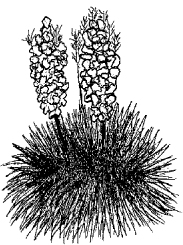
Yucca
Fast-growing, short-lived deciduous trees that, although not legumes, are nitrogen-fixing and create dark soil. Species range in height from 15–80 ft.
Alders are used as a nurse crop for other trees and they provide shelter, mulch and compost material. Wood is used as firewood, and the timber burned to “smoke” fish and other seafoods. Alder bark contains anti-inflammatory compounds and the hard wood is used to make furniture and musical instruments.
Upright annuals up to 3 ft of which grain amaranth (e.g. A. hypochondriacus) and leaf amaranth (e.g. A. cruentus) are the most valuable. Grown in full sun or even partial shade, amaranth are fast-growing shrubs.
Grain amaranth is a gluten-free, high-protein crop (14%) rich in calcium, magnesium, phosphorus, manganese and iron, and vitamins folate, riboflavin and B6. The seeds are eaten popped or ground up into flour.
Leaf amaranth is eaten raw or cooked, and the tasty red and green leaves are high in vitamins A, C and K, and minerals calcium, potassium and manganese.
A dye can be made from the red flowers, some species have edible roots and many species are used as chicken and stock fodder. Leafy varieties can be turned into silage and these species are usually good as cover crops.
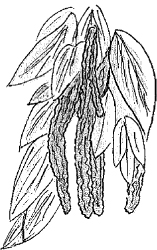
Amaranth
» DID YOU KNOW?
Amaranth is known as a grain, but it is technically a seed. Grain crops are derived from grasses (cereals), but many species of broadleaf plants have seeds that are used in the same way as the cereals. The seeds can be eaten, ground into flour and cooked. Amaranth, along with buckwheat, quinoa and chia, are collectively known as pseudocereals (false cereals).
Fast-growing, long-lived deciduous tree 30–60 ft that is very hardy and survives in poor soils. Nitrogen-fixing, but tends to sucker and can become weedy, has thorns.
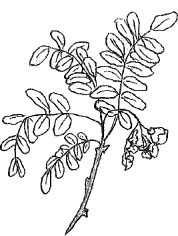
Robinia
Very hard, heavy wood, resistant to rot (good for fence posts), excellent firewood (burns hot and slow), bee forage (honey production) and seed for poultry.
Robinia trees can also be coppiced and the leaves fed to farm animals, while the flowers can be steeped in a cup of water to make a tea or battered, fried and eaten. The roots can also send up suckers, eventually forming an impenetrable thorny thicket. One approach is to graze stock that eat the young suckers.
Fast-growing, nitrogen-fixing, short-lived (68 years) small tree (12–20 ft). Leaves have 20% protein, and while they are poorly digested, they still make a good supplement for other fodder.
Attracts ladybugs for aphid control, extract soap from leaves, good firewood.
Also useful as a windbreak, shelter tree and soil conditioner. Great understory plant.
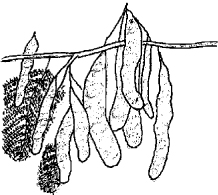
Cape wattle
Flax is an extremely useful annual plant that grows to 3 ft. The fibers of the stalks are high in cellulose and stronger than cotton. Flax seeds are very high in protein, polyunsaturated fats, fiber, magnesium, phosphorus, iron, zinc and thiamine.
Linseed oil is extracted from its seeds, and while it is an edible oil, it is mainly used as a sealer for timber and to make putty and varnishes, and some years ago the floor covering “linoleum.” Beware: as the oil quickly oxidizes in air and several chemicals are usually added to it in its processing, it is not that suitable for human consumption.
Flax fibers make linen, are blended with wool and synthetic materials to make a range of fabrics, and can be used to make canvas and paper.
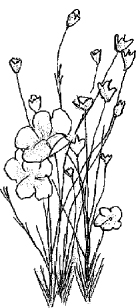
Flax
About 200 species of shrubs and trees found throughout the Northern Hemisphere. Long-lived hedge and windbreak, habitat and shelter for wildlife, tough but thorny and tends to sucker, and tolerates shade and poor soils. Trees can be coppiced for continual supply of firewood, fencing timber and tool handles.
Edible berries that are made into jam, wine, jellies or juiced for drinks. Some species have edible leaves that are added to salads when young and tender.
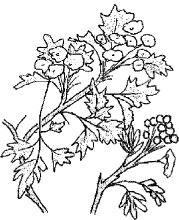
Hawthorn
There are many cultivars of hemp that contain little or no psychoactive drug compounds, and are more than suitable to make clothes, rope and paper, biofuel and oil from its edible seeds (seeds mainly for animal and bird feed).
Hemp plants are fast growing and mature after three to four months. They require less fertilizer, weed control, insecticides and herbicides than some other crops such as cotton.
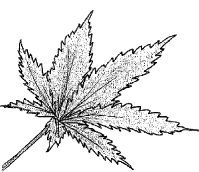
Hemp
Large deciduous nut trees from Asia and North America that typically produce tough and hard timber, which is used for tool handles, bows, skis and wheel spokes. High energy wood for burning in stoves and for smoking meats. Not all species have palatable nuts for humans and many are only used as an adjunct to animal feed.
The pecan (C. illinoinensis) is the most important commercial tree of this genus. Pecan nuts are high in fiber, protein and fat (mainly mono- and polyunsaturated), and they contain reasonable amounts of magnesium, phosphorus, copper, manganese, zinc and thiamine.
There is debate about how many species of paulownia exist (estimates of 6–20) as there are large numbers of crosses and variants as paulownia trees have been cultivated for a few thousand years.
All are quick-growing, drought-resistant deciduous trees, with some growing up to 50 ft. Characteristic very large leaves that are useful fodder for stock, light but durable timber used to make fine furniture and chests, and the trees are used in agroforestry to shelter various crops.
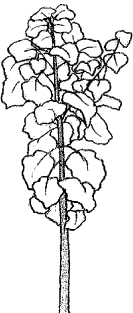
Paulownia
Caution: not a good tree beside buildings or ponds as the root system is highly invasive and capable of lifting concrete. New shoots erupt from damaged roots.
» DID YOU KNOW?
The paulownia group of trees are the fastest growing in the world. They can grow up to 13 ft in one year.
However, the fastest growing plants are the bamboos. Larger varieties can grow nearly 3 ft in one day (that’s half an inch every 20 minutes), and as the 100–130 ft high culms (stalks) reach maturity in one year, the average growth rate over the whole year is 4 in a day.
A relatively small (to 30 ft), short-lived (20 years) deciduous tree, white cedar is related to the neem (same family) and has similar insecticidal properties (but in milder levels).
The timber is resistant to termite attack and is used to make furniture, it coppices well (useful firewood source), and the berries (poisonous if eaten, except for some birds) and leaves can be used to make a garden spray for pest control. However, it spreads easily and can become invasive.
Many other useful plants are grown in the temperate and milder regions of the world and these include goji berries, blueberries and blackwood (Acacia melanoxylon).
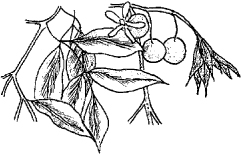
Cape lilac
Amla, also known as Indian gooseberry, is a medium-sized deciduous tree. While it can grow in a range from light to heavy soils, it does need protection from excessive sunlight and strong wind.
Dried amla berries are soaked in oil and the extracted oil-soluble vitamins are used in shampoo and hair conditioner. Its large fruit, although tart, can be picked and eaten, contains high levels of antioxidants and therefore has health benefits. The timber and branches are used as firewood.
There are over 1,000 species of bamboo, which are generally grouped into two types — clumping and running. Generally, the tropical and subtropical varieties are clumpers and the temperate varieties are runners.
Running bamboos spread and can invade under the fence into neighboring yards, so it is best to use them in larger properties or where stock can eat and maintain them to a confined area.
Bamboos belong to the grass family, but unlike other grasses that have their leaf sheath wrapped around the stem, bamboos have a short petiole that attaches the leaf to the branch.
You can further identify running types as most have a flattened edge on alternate sections of the culm (the upright stalks or stems) while clumpers tend to only have round culms.
Bamboo is a true multifunctional plant. Some are used as food or fodder, others as shelter and windbreak, and many have structural uses to make buildings, bridges, pergolas and as reinforcing in concrete.
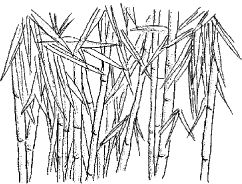
Bamboo
Cacao (pronounced “kah kow”) is also known as the cocoa (pronounced “ko ko”) tree and it supplies cocoa, chocolate and cocoa butter. An evergreen, understory tree in rainforest areas, the cacao produces large pods that contain many seeds or “beans.”
The seeds contain about 40% fat as cocoa butter and this is the main ingredient of chocolate. The sweet, white pulp surrounding the seeds is used to make juices and jellies.
Cacao trees are normally established under shade and they are very susceptible to both cold weather and high temperatures. They are very hard to keep alive outside of tropical areas, but who wouldn’t give them a go if they can make chocolate?
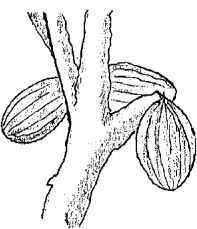
Cacao pods
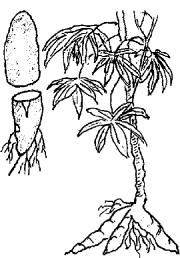
Cassava
The tuberous roots of this plant are boiled like potatoes and eaten for their high starch content. The dried starch (called tapioca) is also used as a thickener. Cassava must be cooked to detoxify it as it does contain cyanide.
Cassava plants are typically grown as an annual and the whole plant pulled to harvest the roots. The stems can be sliced into cuttings and then planted for next year’s crop. This short woody shrub can tolerate a wide range of soils, can withstand drought and survive in low rainfall areas.
The tubers also contain fair levels of vitamin C and calcium.
» DID YOU KNOW?
Underground food crops can be either bulbs, corms, roots, tubers or rhizomes, all of which can act as storage organs for the plant. Onions are bulbs as these are layers of modified leaves, taro is a corm as this is a swollen stem at just below ground level and is a strategy to survive drought or adverse seasonal weather (the plant may die back in winter and will regrow in warmer conditions).
While a carrot is a swollen taproot, the cassava and sweet potato have swollen tuberous roots. These swellings are enlargements of secondary or lateral roots, away from the main taproot. The common potato is a tuber, which is a swollen stem part, as it contains the normal parts of stems such as nodes (eyes of potato) and both have similar internal cell structure. Ginger, turmeric, bamboo and arrowroot have rhizomes, which are swollen horizontal underground stems.
Moringa oleifera is a fast-growing deciduous tree that has edible leaves and seed pods. Fuel and cosmetic oil is derived from its seeds and some of the substances left in the seeds after the oil is extracted show promise for the disinfection of contaminated water.
Called the drumstick tree after the long slender seed pods, it is also known as the horseradish tree after the taste of its roots (which obviously taste like horseradish). It is fairly drought tolerant but doesn’t survive continuous cold weather and frost.
Moringa leaves contain high levels of protein, vitamins A and C, and minerals calcium, magnesium, iron and potassium.
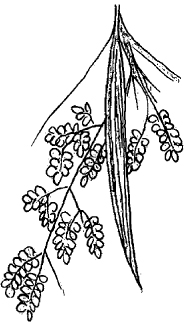
Drumstick tree
Fast-growing, nitrogen-fixing, evergreen tree to height of 30 ft and spread of 12 ft. Drought and frost sensitive when young. Seed pods up to 20 in or more depending on the species or cultivar. The white pith, with a cotton wool texture, around each seed can be eaten and tastes like vanilla ice cream. Wood can be used for furniture and the leaves for feeding stock.
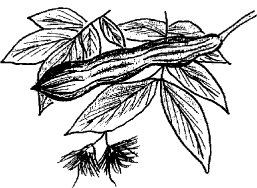
Ice-cream bean
The Indian tulip tree or Portia tree is a fast-growing, evergreen tree (but can shed its leaves in some areas) to about 30 ft high. It does tolerate a wide range of soils and prefers coastal regions. The bark and leaves have traditional medicinal uses, and the fruits, flowers and young leaves are all edible.
The tough, fibrous bark is made into rope. Yellow and red dyes are obtained from its fruits, flowers and bark. Its timber is used to make paper and its colored wood is used to make furniture, musical instruments and carvings (including bowls and plates).
Neem is a fast-growing, evergreen tree that is drought resistant, produces good shade and can tolerate a fair range of soils, although it seems to prefer sandy soils. Neem trees won’t survive in heavy waterlogged soils nor cold climate regions in the world.
The fruits and seeds of the neem are the source of neem oil, which is used as a lubricant, to make soap and cosmetics, and to repel insect pests in orchards. Neem leaves can be dried and placed in cupboards or pantries to prevent insect attack of clothes, seeds and food. The tender shoots and flowers can be eaten as a vegetable, the slender twigs are used as a toothbrush, the gum is a rich source of protein and used as a bulking agent in prepared foods, the wood is used to make furniture, the bark has a high tannin content and is used in the furniture industry, and its fibers can be woven into ropes. No wonder some people call the neem the most useful tree in the world.
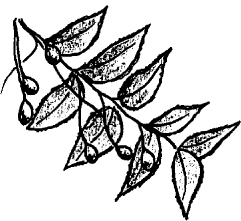
Neem
Many seeds of tropical and subtropical plants have short viability. They are known as recalcitrant seeds and must be sown within a few weeks of collection. They do not keep well, as they dry out quickly or suffer with exposure to both low and high daytime temperatures. It is common to see some seeds germinating in mature seed pods. Recalcitrant plants include the neem, ice-cream bean and drumstick tree, as well as mango and avocado, discussed in an earlier chapter.
Now grown throughout the tropical world, the rubber tree (also known as the Pará rubber tree) produces a milky white sap called latex, which is used to make natural rubber.
Special vessels in the bark spiral anticlockwise upwards and carry the latex. By carefully cutting the bark on an angle (clockwise) the vessels are intersected and latex can flow downwards and then into a small bucket.
Many other plants also contain the milky elastic sap but none has the production of this tree.
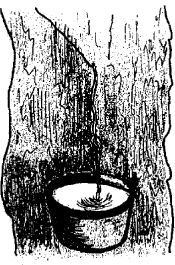
Rubber
The tamarind is a medium-sized tree that tolerates a wide range of soils, and withstands occasional drought and salty air in coastal regions. It makes a good windbreak, but does not tolerate waterslogging, frost or shady conditions. Besides the edible pulp in the pod-like fruit, the tamarind has dark red heartwood timber that is used in many furniture applications.
The pod pulp is high in iron and magnesium with good levels of the vitamin B group, calcium, potassium and phosphorus. The fruit is used as a flavoring for many dishes, including desserts, and is made into jam and sauces. Both ground seeds and leaves are high in protein and used as fodder for animals.
Many other tropical and subtropical plants are extremely useful, including ginger, cotton, coconut, jute, sapodilla and coffee.
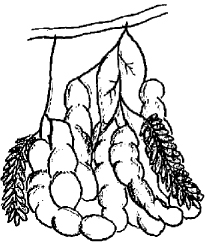
Tamarind